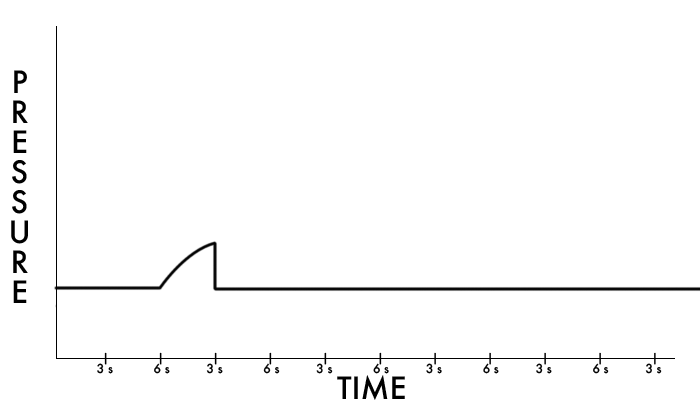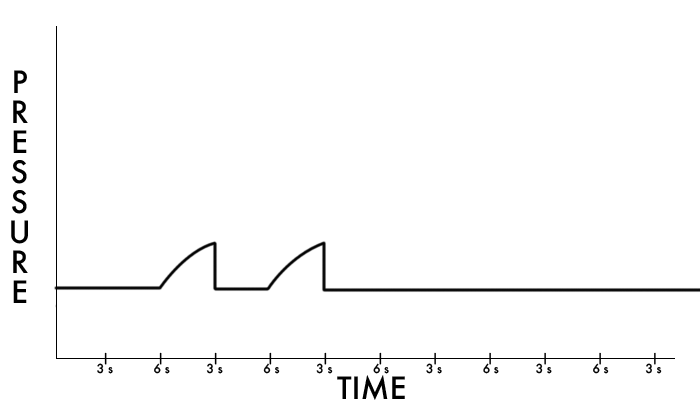Here we discuss the modes of ventilation that fully support respirations. Some of this terminology varies by equipment manufacturer, but is generally understood by most providers.
Read the other entries from this series here: (1), (2), (4), (5), (6)
Two broad categories of ventilator modes exist: modes that breathe for the patient and “spontaneous” modes that help them breathe for themselves. This distinction is loose, and most modes are actually a combination, but the key difference becomes clear in an apneic patient making no spontaneous effort to breathe. Will the vent breathe for them (i.e. mandate a minimum respiratory rate and tidal volume), or not? The former modes are sometimes referred to as “control” modes.
The most basic control mode is…
Controlled Mandatory Ventilation (CMV)
Control modes are largely defined by how they respond to patient respiratory effort, and CMV takes the simplest approach: it ignores it.
With CMV, you set a respiratory rate: let’s say 10 breaths per minute.
10 breaths per minute is one breath every 6 seconds. So, at time zero, a breath is delivered using whatever metrics you prefer. It looks like this:

After that, a timer begins to tick. Once it reaches 6 seconds, the next breath is delivered, identical to the first.

This continues until eternity.

Each breath is 6 seconds apart, and has the same tidal volume, pressure, flow—whatever we set it to have.
What happens if the patient attempts to breathe before the timer is up? Nothing. The ventilator gives them no air.
What happens if the patient doesn’t like our breaths (for instance, the set tidal volume)? Too bad. They get it anyway.
CMV is therefore rather uncomfortable for most patients, since it takes all control away from them. It is typically only tolerated in deeply sedated, paralyzed, or comatose patients, and even then usually offers no benefit over “friendlier” modes. Nowadays you tend to see it only on simplified transport ventilators (or maybe in hospitals that haven’t upgraded equipment since the ’80s) that lack the more modern functionality.
What would a more patient-friendly mode look like? Something like…
Assist Control (AC)
AC is the default control mode in most modern critical care settings.
Like CMV, AC allows you to set a rate, and define the characteristics of the machine breaths. Like CMV, if you set a rate of 10, then every 6 seconds, the patient will get a breath from the vent.
However, the difference becomes apparent if the patient attempts to breathe on their own before the timer is up. If we’re at 3 seconds and the patient generates some spontaneous effort, the vent will sense this and deliver the breath early. This will be the exact same type of breath as the others, but it will be triggered by the patient, not by the timer. The timer will now “reset,” and a full six seconds will start ticking down again.

A note for the interested: patient effort can be sensed in one of two ways, either pressure-triggering or flow-triggering. As the patient tries to breathe, they will suck on their airway, creating negative pressure; by exceeding a set threshold (say, -2 cm H2O), the breath can be initiated. Alternately, and with perhaps less effort for the patient, the breath can be triggered by the patient generating a certain amount of flow (say, 2 LPM), regardless at what pressure.
Typically, respiratory therapists set the trigger type and threshold, trying to minimize work by the patient (for comfort) while avoiding accidental or false triggering. However, occasionally it’s worth fiddling.
Whatever the case, you see now that in AC, a breath can be triggered either by time (if there is no patient effort before the timer runs out), or by the patient (by sucking at the tube and generating pressure or flow). Either way, they get a mechanically-defined breath.
Can we offer the patient still more control? We can, with…
Synchronized Intermittent Mandatory Ventilation (SIMV)
Like AC, SIMV allows a set respiratory rate. Like AC, when the timer on the rate runs out, a mechanical breath will be delivered.
And like AC, it allows patient-initiated breaths before it’s time for the next time-triggered breath. However, it differs from AC in how those breaths are delivered. Spontaneous breaths are patient-defined rather than ventilator-defined.
Timed breaths have the tidal volume and other traits we selected. Spontaneous, patient-triggered breaths have no such requirements; they will be whatever the patient generates on their own.
They will have no set tidal volume, no set inspiratory time, no set flow. They will only have the FiO2 (which does not change), the set PEEP between breaths (which does not change), and if desired, we can offer them some pressure support to assist their breath (more on this later). Otherwise, they’re on their own.

Does the timer reset when the patient triggers a breath? No! If it did, the patient could trigger frequent tiny, useless breaths, and if they did so frequently enough, they would never receive a full vent breath.
However, if a patient-triggered breath occurs close enough to a machine breath—often within a time window of about 30% of the respiratory cycle, or around .5 seconds—then the vent will turn that breath into a full machine breath (just like AC) and reset its timer. This is what makes it “synchronized” IMV; without this feature, the vent would wholly ignore the patient breaths, and could easily “stack” a machine breath on top of a patient breath, causing patient discomfort and an unsafe tidal volume.
SIMV came into vogue with the perception that it was a healthy blend of full support—since it mandated a minimum amount of ventilation—and patient effort, since patient-triggered breaths were totally spontaneous and patient-defined. This was thought to “keep patients strong” and improve comfort by limiting patient-ventilator dyssynchrony. It was even used as a method of weaning: by gradually dialing down the set rate, the patient would be forced to take more and more unassisted spontaneous breaths, until they were breathing wholly on their own, at which point they could be extubated.
This fell somewhat out of favor with the publication of data suggesting that “SIMV weans” were no safer than other methods and mostly just prolonged intubation time. However, some providers are still fond of SIMV, particularly for patients with healthy lungs, such as many in the surgical population.
This segues into next time, when we’ll discuss purely spontaneous modes of ventilation.
